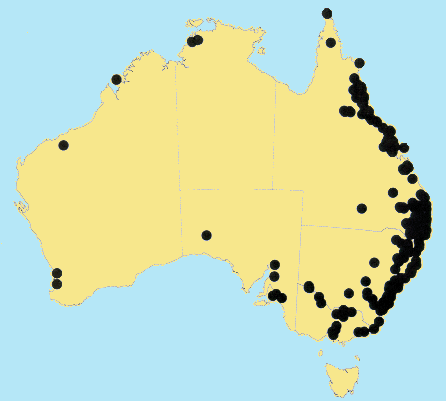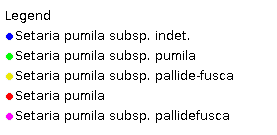Setaria pumila* (Poir.) Roem. &
Schult. Syst. Veg. 2: 891 (1817).
Classification. (GPWG 2001) : Subfamily
Panicoideae. Paniceae.
Basionym and/or
Replacement Name: Panicum pumilum
Poir., Encycl., Suppl. 4: 273 (1816).
Type of Basionym or
Protologue Information: HT: Herb. Desfontaines s.n., (FI; IT: P).
Recent synonyms: S. glauca, S. lutescens.
Key references
(books and floras): [1878] G.Bentham, Flora Australiensis 7 (492 as Setaria
glauca), [1952] C.A.Gardner, Flora of Western Australia 1 Gramineae
(266 as S. lutescens), [2002] D.Sharp & B.K.Simon, AusGrass,
Grasses of Australia, [2002] J.Wheeler, N.Marchant & M.Lewington, Flora
of the South West (433 as S. gracilis), [2006] J.Jessop, G.R.M.Dashorst,
F.M.James, Grasses of South Australia (483), [2008] S.W.L.Jacobs,
R.D.B.Walley & D.J.B.Wheeler, Grasses of New South Wales (370).
Illustrations:
[2006] J.Jessop, G.R.M.Dashorst, F.M.James, Grasses of South Australia (483, Fig. 417 as subsp. pumila),
[2008] S.W.L.Jacobs, R.D.B.Whalley & D.J.B.Wheeler, Grasses of New South
Wales, 4th edn (370).
Habit. Annual.
Rhizomes absent. Culms erect or geniculately ascending, 5–130 cm tall. Mid-culm
nodes glabrous. Ligule a fringed membrane or a fringe of hairs, a ciliolate
membrane. Leaf-blades flat or conduplicate, 3–30 cm long, 2–10 mm wide.
Leaf-blade surface scabrous, glabrous.
Inflorescence.
Inflorescence solid, a panicle. Panicle linear, 1–10(–20) cm long.
Spikelets.
Spikelets pedicelled, 1 in the cluster. Involucre composed of bristles, free
throughout. Fertile spikelets 2-flowered, the lower floret barren (rarely
male), the upper fertile, comprising 1 basal sterile florets, comprising 1
fertile floret(s), without rachilla extension, ovate, dorsally compressed,
1.5–3.5 mm long.
Glumes. Glumes
thinner than fertile lemma. Lower glume orbicular, membranous, without keels, 3
-nerved. Upper glume ovate, 1.4–2 mm long, membranous, without keels, 5
-nerved. Florets. Basal sterile florets 1, male or barren, with palea.
Lemma of lower sterile floret 100 % of length of spikelet, membranous, 5
-nerved.
Fertile lemma 1.5–3.5
mm long, without keel. Lemma apex mucronate. Anthers 3.
Continental
Distribution: Europe, Africa, Temperate Asia, Tropical Asia, Australasia,
Pacific, North America, and South America.
Australian
Distribution: Western Australia, Northern Territory, South Australia,
Queensland, New South Wales, Victoria.
Western Australia: Drummond. Northern Territory:
Darwin & Gulf. South Australia: Flinders Ranges,
Northern Lofty, Murray,
Southern Lofty. Queensland: Burnett,
Cook, Darling Downs, Leichhardt, Maranoa, Moreton, North Kennedy, Port Curtis,
South Kennedy, Wide
Bay. New
South Wales: North Coast, Central
Coast, South Coast,
North-Western Slopes, Central-Western Slopes, South-Western Slopes. Victoria: Murray
Mallee, Riverina, Eastern Highlands, Gippsland Plain, East
Gippsland.
Notes.
Introduced. Widespread, esp. in eastern Australia. Flowers Jan.-June.
Although ssp. pumila
differs from ssp. subtesselata in its larger spikelets, Clayton
(1977) gives evidence of continuous variation between the two forms and are
recognised by him as synonyms of S. pumila. Other commonly used names
now placed in synonymy, S. glauca and S. lutescens, are both
based on Panicum glaucum which is a species of Pennisetum.
The absence of a short
knotty rhizome is the only character that distinguishes this species from S.
gracilis.
Introduced; tropical
and subtropical rain forests, tropical and subtropical wet sclerophyll forests,
dry sclerophyll forests, Brigalow forests, tropical and subtropical sub-humid
woodlands, and semi-arid shrub woodlands. Flowers Jan.-June.
Infra-specific
taxa: subsp. pumila, subsp. pallide-fusca.
Spikelets less than
2.5 mm long S. pumila
subsp. subtesselata
Spikelets c. 3 mm long
S. pumila subsp. pumila






